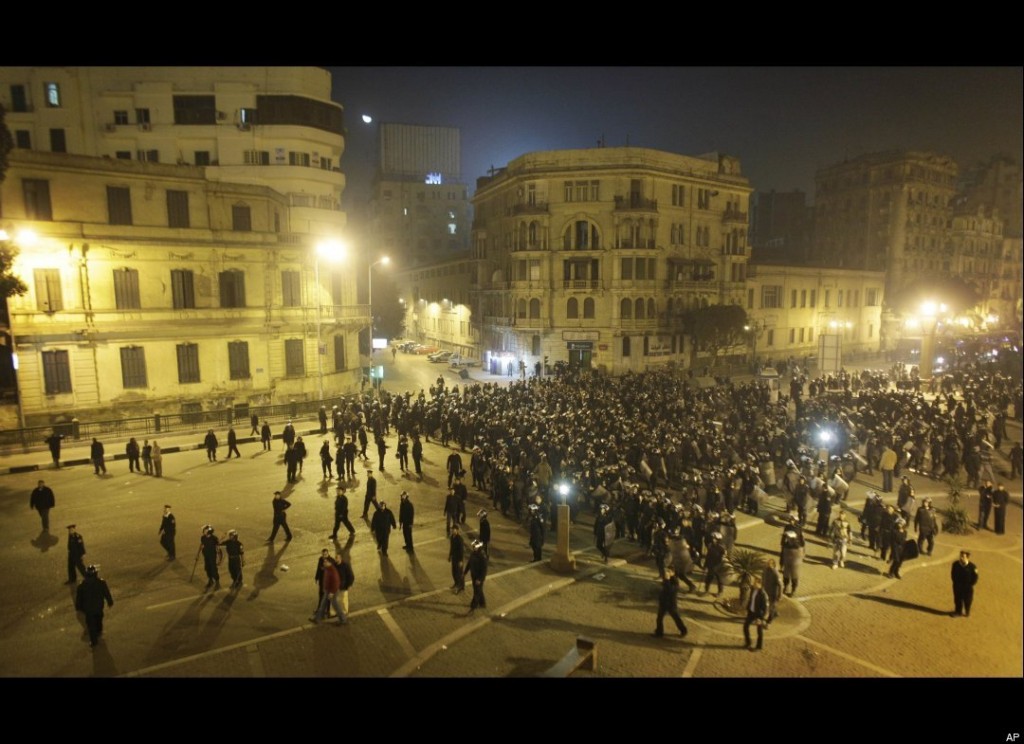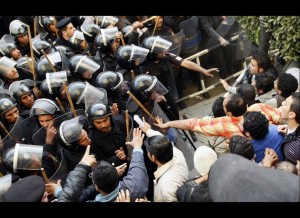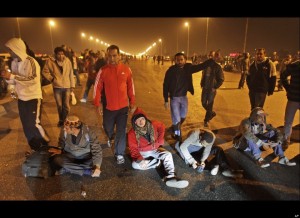Exclusive: Liberating Cairo
Features, New in Ceasefire, Special Reports - Posted on Thursday, January 27, 2011 18:22 - 4 Comments

Jumanah Younis
The build-up to the 25th of January day of action in Egypt, originating from a Facebook event that attracted over 60,000 attendees, was considerable. Rumours spread of a Tunisian-style revolution, and on the morning of the 25th the streets of Cairo were eerily quiet. Plainclothes policemen lounged around barricades and metro station entrances, chatting with uniformed officers and waiting for something to happen. By 2pm only a handful of protestors had gathered in Tahrir Square, and there was the dread that the hype had been unsubstantiated, and that the state’s overbearing security had succeeded in scaring most people away from the streets.
I arrived in Tahrir Square, the main plaza in the heart of Cairo at 4pm, and was greeted with the sting of tear gas in my eyes and lungs. The roundabout which sits in the middle of the square was completely overrun with people, and the usual sound of klaxons was conspicuously absent, replaced instead by the low bang of cannons and the shout of slogans. At least ten (some sources say up to twenty) thousand people had turned out and occupied the centre of the city, some with banners, many without, while nervous onlookers stood behind the railings and marvelled at what was the largest demonstration since Mubarak came to power.
I joined the crowds as they attempted to march down Kasr-al Aini Street towards the parliament building. Lines of riot police blocked the entrance to all surrounding roads, and the crowd was driven back, first by tear gas, then by water cannons. The atmosphere was electric, and though the police presence was heavy, there was a feeling of safety in numbers. Protests in Egypt usually take place outside specific courts, unions or government buildings, but they tend to number no more than a few hundred people, hopelessly outnumbered by armed riot police. The nature of Tahrir Square, always blocked with traffic and people, means that demonstrations there are rarely possible. In a sense, the fact that the protest had managed to occupy the square in itself strengthened the spirit of demonstrators, and the numerous members of the press in attendance gave us confidence that the world was watching.

The Egyptian government was also aware of the media presence, and was conscious not to create a state of anarchy that could resemble the recent revolution in Tunisia. So, although the police were firm in not allowing the protest to move to parliament, beating those on the front line who tried to push forward, they did not move into the crowd as many had expected. The crowd surged forward repeatedly, meeting the line of riot police who used their batons indiscriminately to force people back. A routine ensued: protesters would push forward to the police line, receive a rain of baton blows, but manage to push the police back by a few yards. On the way, people would stop to pick up stones to throw over the crowd onto the police. After a few minutes a few people would struggle back through the crowd towards the square, carrying the injured and shouting for water. The police would then regroup and run forward in formation, shields at the fore, batons raised. The stones that protestors had thrown were then returned with a vengeance, causing further injuries, mainly to the head. This would cause a stampede running back towards the square, as those standing on the side shouted in vain for people to stand their ground.
This continued for at least an hour in varying degrees. At one point it looked like the police were going to move forward and block off part of the square, but they were driven back by protestors shouting ‘freedom’ and ‘get out Mubarak’. The crowd was predominantly male, although many women were present and could be heard leading some of the chants. The demonstration as a whole involved a cross-spectrum of Egyptians, and the shouts of ‘God is Great’ were matched in frequency by the call for ‘freedom’. Though I was frequently told, as an unaccompanied woman, to stay at the back of the crowd for my own safety, there was no sense that I shouldn’t have been there.
Despite the fact that demonstrators were unable to march on parliament, there were still many moments of triumph. The fire truck that was linked to the water cannon was abandoned by the police. A protestor climbed on top of it holding an Egyptian flag, and proceeded to lead the crowd in a moving rendition of the Egyptian national anthem. The national anthem, entitled ‘my country’, recurred frequently throughout the protests that day.
 As the call for the afternoon prayer rang out over Cairo, the police did a final push forward and threw more tear gas, ignoring shouts from the crowd that there were people praying in the square. By the late afternoon and early evening, the crowds were still chanting at the police lines – pushed back to their original location – but clashes were becoming less frequent and many people had retreated to form groups further into the square itself. The atmosphere became more relaxed, and I realised that though the police barricades were extensive, people were still free to come and go from one or two exits. I left to find food and water, and returned to find that many others had done the same; sitting on the road with takeaways, the sound of slogans still strong in the background.
As the call for the afternoon prayer rang out over Cairo, the police did a final push forward and threw more tear gas, ignoring shouts from the crowd that there were people praying in the square. By the late afternoon and early evening, the crowds were still chanting at the police lines – pushed back to their original location – but clashes were becoming less frequent and many people had retreated to form groups further into the square itself. The atmosphere became more relaxed, and I realised that though the police barricades were extensive, people were still free to come and go from one or two exits. I left to find food and water, and returned to find that many others had done the same; sitting on the road with takeaways, the sound of slogans still strong in the background.
The square began to take on the form of a liberated space. In a country where going on a protest is considered an unnecessary risk by most, a relatively stable space for expressing opposition to the government, with some level of anonymity, was completely novel. A feeling of comradeship, despite manifest differences in aims and beliefs, grew in the crowd. By 8pm, the demonstration still five thousand strong, people were walking around handing out bread, water, dates and even surgical masks; while cigarettes and cans were also proffered by business-savvy street vendors. There was no imminent threat of dispersal, and talk quickly spread of staying the night. The success of the demonstration up until that point, and news of protests in other parts of Egypt, kept morale high in the crowd, and the arrival in Tahrir Square of a demonstration from another area of Cairo boosted confidence in numbers.
By 11pm I was exhausted, and – being a woman without any male company – decided it would be a bad idea to stay the night. The atmosphere when I left was relaxed and there was no feeling of impending clashes with police. The rest of the night’s events I pieced together from the accounts of people I met the next day who had stayed. Between one and three o’clock in the morning the police fired large amounts of tear gas into the square, before opening fire with rubber bullets and proceeding to chase all remaining protestors. The crowds scattered in all directions. A young Egyptian musician I met the next day, who asked to walk with me in the street for fear of random police searches should he walk alone, told me he had stayed in Tahrir Square that night. ‘I was okay because I can run fast, but even me running fast they nearly catch me. The policeman he looked like he really wanted to get me … I was scared. They took one of my friends.’
By the next day, the streets had returned to an uneasy normality. Tahrir Square was overrun by riot police and several roads were blocked. A repeat of the previous day would have been impossible, so several smaller protests took place instead, scattered across the city. They were heavily policed and brutally put down. One protest I attended in an area called Ramses was attended by no more than 150 people. I arrived to find tyres burning in the road; a no man’s land between protestors and riot police on the other side. In a moment of complete surrealism, the police opened fire on protestors with rubber bullets and protestors responded with stones, as cars sped through the crossfire in a desperate attempt to escape trouble. The feeling of optimism from the previous day was quashed by the visibility of the police state, manifest on every street downtown and especially in Tahrir Square. At around 9pm on the 26th, police closed off the main shopping street, Talaat Harb, leading off from Tahrir Square. They said there was a demonstration. I crossed onto the road parallel and got onto Talaat Harb from a side street, and found there was no demonstration. A few straggling shoppers and shop keepers watched from the pavements as the police began to run forward in formation. Displays of state strength and control like this were repeated throughout the evening.
The situation at the moment is tense, but optimism remains. Protests have continued in other cities in Egypt, some in solidarity with others to ease the pressure of the police and force the state to spread its security resources. Anticipation is building for Friday as protests have been called for after the Friday prayer (a significant event because almost all male, Muslim Egyptians attend). The government has stated that further protests are illegal and will be punished by any means necessary, but defiance is building and the police look nervous.
Jumanah Younis is a writer and activist. She is studying Spanish and Arabic at Pembroke College, Oxford, and is currently living in Cairo.
4 Comments
Anon
Excellent reporting – well done
Latifa
Handouts of water bread and dates, wouldn’t get that in london. V. interesting.
Adam
Yesterday we were all Tunisians … Today we are all Egyptians …. Tomorrow we’ll all be free


Interestingly, ‘Tahrir’ means liberation, no?